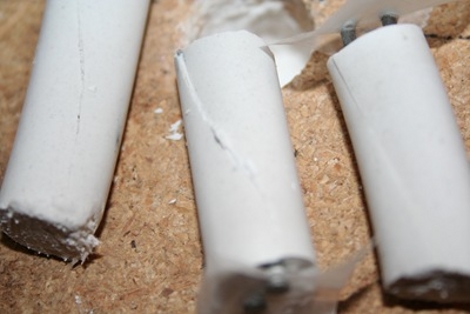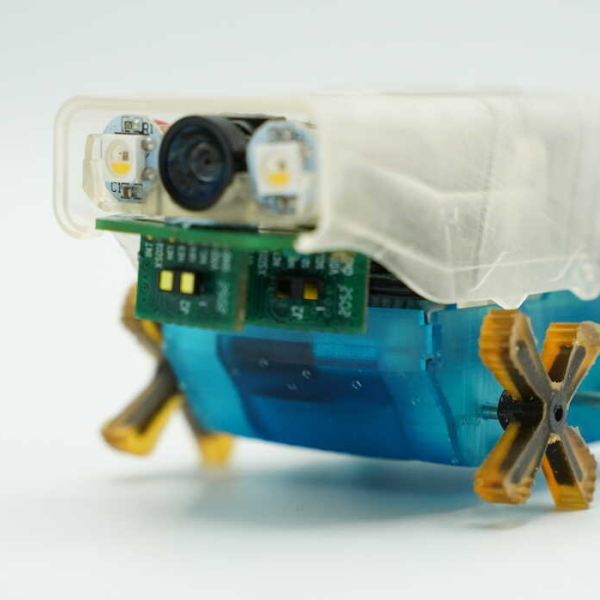
These plugs are cheap, easy to make, and work well for measuring the moisture content of soil. The Cheap Vegetable Gardener came up with this method in order to add automatic watering to an automated grow system. Plastic tubing is used as a mold for Plaster of Paris. Once the plaster has been poured, two galvanized nails are inserted. These are won’t rust and work as probes, measuring the resistance of the dried plaster (gypsum). When inserted into the soil, the moisture content within the gypsum will fluctuate along with the soil. As moisture rises, the resistance between the probes falls, which can be monitored by a microcontroller and used to trigger or stop a watering system.
[Thanks Juan]
















Hmm, could be used in green houses and or orchards for a point specific watering system. Might make for a more efficient watering system. Course that would mean installing a rather complex solenoid valve system.
this is just what i was looking for!
I ran across this website a year ago and copied his idea for these sensors in my sprinkler controller. These work very well. In mine, I measured several 100K resistance when dry all the way down to 5K or so when saturated.
Been using this kind of system for a while. I’ve found that nails get in the way and produce noise if they contact the soil directly. The easy solution was to skip them entirely and run the wire leads right into the gypsum plugs. Just strip the insulation off the ends that will be completely sealed in the plaster.
@Polymath
Most places that I’ve seen already have a bank of valves for watering zones at different rates. Usually they just run on timers. This allows you to be smarter about it and not water when it rains, etc.
The next logical step- I’m connecting mine to my network so I can use weather forecast data and neighborhood watering schedules in my sprinkler algorithm.
Whats the lag like WRT soil moisture and sensor moisture, thats a very dense sensor in relatively well drained soil.
Problem: Galvanized or not, DC current will eventually corrode the electrodes as electrolysis will happen. Measuring conductivity requires a more sophisticated circuit that provides for an AC (ie: 1KHz) current. As a side note, measuring with precision also requires a thermometer integrated into the probe, as the resistance changes dramatically with temperature.
It will work, but you will eventually have to replace your probes. Also applying the current for a short time using an IO pin for the voltage source could make the probes to last longer.
It doesn’t require a very sophisticated circuit to measure with AC. Just hook up the sensor between two uC pins so you can switch polarity.
I agree with @Ivan’s comments. AC is the better way to measure soil resistance.
As to the matter of electrode materials, I wonder if a couple of stainless steel bolts would make better electrodes than the galvanized nails.
Thinking out of the box, how about graphite? It’s conductive enough for this application, and relatively inert. You can buy it in blocks, rods, and bars that can be machined to the shape you want.
+1
Graphite and stainless have been used in commercially available probes for about 20 years
Titanium or Lead would also make good materials.
I know of a similar construction used as monopole potential electrodes for soil measurement. The used lead spirals in the gypsum. These electrodes had also the property of very little electrical polarisation. This was some kind of electrochemical reaction and a balance between PbSO4 and CaSO4. But as the polarisation was not zero, they had to be equalized regularly after a measurement session. That means they were all shorted together and put into a tub of salt water.
typo: These are won’t rust and work as probes[…]
good hack though, would be handy to stop me murdering pot plants :)
@spiderwebby. pot or potted?
This has been around for decades. most commercial ones use silver coated copper wire (silver solder tin your wires to get the same thing) then silicone at the top and typically a “hat” t hat is 3X the diameter of the sensor to shield it from rain.
Ivan, I completely agree. I chose this option mainly for the lack of needed components. Given how cheaply you can make these replacing a probe once a year is a decent option.
When I finally make my grow box controller arduino shield (PCB) I most likely will go with the AC circuit.
At the moment my grow box is sporting hydroponics so need for soil sensor but will be back in action in the next couple weeks.
@djrussell: lol, potted :P
Actually made a few of these for a school project last year, and they work great if you just apply brief pulses to them (we used a 555 timer). Each turned out a bit different though, so make sure to characterize each one individually and don’t expect precise results, just a nice relative measure.
very clever use of plaster-o paris. I noticed it’s ability as a sponge but never thought of how to apply it.
So does anyone have any references for making an a/c (from a d/c circuit) variety of soil sensor? Alot of sites seem to use discontinued ICs for their oscillators/vco.
What about a capacitive version of the sensor?
You don’t need a VCO. Any oscillator will do, e.g. a 555, if you want, or two CMOS inverters or one schmitt trigger inverter. You just use an output capacitor and an input capacitor for the other electrode and a pull down/load/measuring resistor. Then two diodes and one or two caps as a peak value rectifier.
I agree with pookey and Ivan, graphite is a much better idea and I’ve been meaning to try it myself.
Also, plaster of Paris is not waterproof – it will turn into soggy mush. What about concrete or fired clay instead?
What about using graphite instead of metal electrodes? That should last you forever. Resistance will be higher though, but shouldn’t be too bad.
oops, never mind – bit slow
What about plant moisture sensors – one needle or small two-pronged fork per plant? For it to be practical, the cost of such device should be less than 1 USD + reusable I imagine.
I would rather use something like this: http://translate.google.de/translate?u=http%3A%2F%2Fwww.dietmar-weisser.de%2Fanalogtechnik%2FBodenFeuchte%2FFeuchteSensor_1.php&sl=de&tl=en&hl=&ie=UTF-8
No corrosion at all.
Two io pins could be used to create 1kHz square wave ac. Switch between 01b and 10b.
One pin and an output capacitor is enough.
This is really cool, I had a go at making some myself (http://www.stealthcopter.com/blog/2010/03/diy-soil-moisture-sensors/). Resistance was ~12k in air, 4K in water and seems to take a very long time for the water to leave (after 20mins resistance has only increased to 5.6K).
And I agree with Simon, something that doesn’t degrade in water would be better, perhaps normal plaster?
I developed a system many years ago that used two powdercoated rods accurately spaced apart. They were inserted in the soil and I used a circuit that measured capacitance between the rods. The capacitance varies tremendously with the change in moisture.
My experience with plaster is not so good. it desintegrates fairly quick (say at the end of the season), they react slowly and there still will be corrosion, both by electrolysis and bu direct contact with wetness.
Galvanized nails -at least for me- seems the best choice
Very nice… The simplicity of the whole project astounds me. Love the idea of using galvanized nails! Because of so many issues with sensors corroding I ended up getting this soil moisture sensor. I can’t believe this whole time I didn’t think of using a galvanized sensor to solve the problem! I guess that’s why sites like this are around, to enlighten those like me who need help seeing cool and logical ideas…